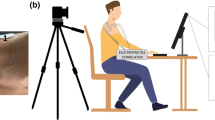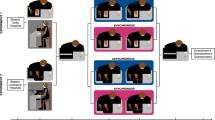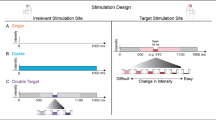Abstract
Tactile discrimination performance depends on the receptive field (RF) size of somatosensory cortical (SI) neurons. Psychophysical masking effects can reveal the RF of an idealized “virtual” somatosensory neuron. Previous studies show that top–down factors strongly affect tactile discrimination performance. Here, we show that non-informative vision of the touched body part influences tactile discrimination by modulating tactile RFs. Ten subjects performed spatial discrimination between touch locations on the forearm. Performance was improved when subjects saw their forearm compared to viewing a neutral object in the same location. The extent of visual information was relevant, since restricted view of the forearm did not have this enhancing effect. Vibrotactile maskers were placed symmetrically on either side of the tactile target locations, at two different distances. Overall, masking significantly impaired discrimination performance, but the spatial gradient of masking depended on what subjects viewed. Viewing the body reduced the effect of distant maskers, but enhanced the effect of close maskers, as compared to viewing a neutral object. We propose that viewing the body improves functional touch by sharpening tactile RFs in an early somatosensory map. Top–down modulation of lateral inhibition could underlie these effects.


Similar content being viewed by others
References
Alloway KD, Rosenthal P, Burton H (1989) Quantitative measurements of receptive field changes during antagonism of GABAergic transmission in primary somatosensory cortex of cats. Exp Brain Res 78:514–532
Alonso JM, Swadlow HA (2005) Thalamocortical specificity and the synthesis of sensory cortical receptive fields. J Neurophysiol 94:26–32
Arzy S, Thut G, Mohr C, Michel CM, Blanke O (2006) Neural basis of embodiment: distinct contributions of temporoparietal junction and extrastriate body area. J Neurosci 26:8074–8081
Astafiev SV, Stanley CM, Shulman GL, Corbetta M (2004) Extrastriate body area in human occipital cortex responds to the performance of motor actions. Nat Neurosci 7:542–548
Brown PB, Koerber HR, Millecchia R (2004) From innervation density to tactile acuity: 1. Spatial representation. Brain Res 1011:14–32
Craig JC (1989) Interference in localizing tactile stimuli. Percept Psychophys 45:343–355
Craig JC, Evans PM (1987) Vibrotactile masking and the persistence of tactual features. Percept Psychophys 42:309–317
DiCarlo JJ, Johnson KO, Hsiao SS (1998) Structure of receptive fields in area 3b of primary somatosensory cortex in the alert monkey. J Neurosci 18:2626–2645
Downing PE, Jiang Y, Shuman M, Kanwisher N (2001) A cortical area selective for visual processing of the human body. Science 293:2470–2473
Dykes RW, Landry P, Metherate R, Hicks TP (1984) Functional role of GABA in cat primary somatosensory cortex: shaping receptive fields of cortical neurons. J Neurophysiol 52:1066–1093
Eimer M, Driver J (2001) Crossmodal links in endogenous and exogenous spatial attention: evidence from event-related brain potential studies. Neurosci Biobehav Rev 25:497–511
Fiorio M, Haggard P (2005) Viewing the body prepares the brain for touch: effects of TMS over somatosensory cortex. Eur J Neurosci 22:773–777
Forster B, Eimer M (2005) Vision and gaze direction modulate tactile processing in somatosensory cortex: evidence from event-related brain potentials. Exp Brain Res 165:8–18
Freund HJ (2003) Somatosensory and motor disturbances in patients with parietal lobe lesions. Adv Neurol 93:179–193
Graziano MS, Cooke DF, Taylor CS (2000) Coding the location of the arm by sight. Science 290:1782–1786
Haggard P (2006) Sensory neuroscience: from skin to object in the somatosensory cortex. Curr Biol 16:R884–886
Kaas JH, Merzenich MM, Killackey HP (1983) The reorganization of somatosensory cortex following peripheral nerve damage in adult and developing mammals. Annu Rev Neurosci 6:325–356
Kennett S, Taylor-Clarke M, Haggard P (2001) Noninformative vision improves the spatial resolution of touch in humans. Curr Biol 11:1188–1191
Laskin SE, Spencer WA (1979a) Cutaneous masking. I. Psychophysical observations on interactions of multipoint stimuli in man. J Neurophysiol 42:1048–1060
Laskin SE, Spencer WA (1979b) Cutaneous masking. II. Geometry of excitatory andinhibitory receptive fields of single units in somatosensory cortex of the cat. J Neurophysiol 42:1061–1082
Macaluso E, Driver J, van Velzen J, Eimer M (2005) Influence of gaze direction on crossmodal modulation of visual ERPS by endogenous tactile spatial attention. Brain Res Cogn Brain Res 23:406–417
Penfield W, Rasmussen T (1950) The cerebral cortex of man. A clinical study of localization of function. MacMillan, New York
Press C, Taylor-Clarke M, Kennett S, Haggard P (2004) Visual enhancement of touch in spatial body representation. Exp Brain Res 154:238–245
Saxe R, Jamal N, Powell L (2006) My body or yours? The effect of visual perspective on cortical body representations. Cereb Cortex 16:178–182
Taylor-Clarke M, Kennett S, Haggard P (2002) Vision modulates somatosensory cortical processing. Curr Biol 12:233–236
Taylor-Clarke M, Kennett S, Haggard P (2004) Persistence of visual-tactile enhancement in humans. Neurosci Lett 354:22–25
Van Boven RW, Johnson KO (1994) The limit of tactile spatial resolution in humans: grating orientation discrimination at the lip, tongue, and finger. Neurology 44:2361–2366
Weinstein S (1968) Intensive and extensive aspects of tactile sensitivity as a function of body part, sex and laterality. In: Kenshalo DR (ed) The skin senses. Thomas, Springfield, pp 195–218
Xing J, Gerstein GL (1996) Networks with lateral connectivity. I. Dynamic properties mediated by the balance of intrinsic excitation and inhibition. J Neurophysiol 75:184–199
Acknowledgements
This research was supported by grants from the BBSRC and the British Academy to PH.
Author information
Authors and Affiliations
Corresponding author
Rights and permissions
About this article
Cite this article
Haggard, P., Christakou, A. & Serino, A. Viewing the body modulates tactile receptive fields. Exp Brain Res 180, 187–193 (2007). https://doi.org/10.1007/s00221-007-0971-7
Received:
Accepted:
Published:
Issue Date:
DOI: https://doi.org/10.1007/s00221-007-0971-7




